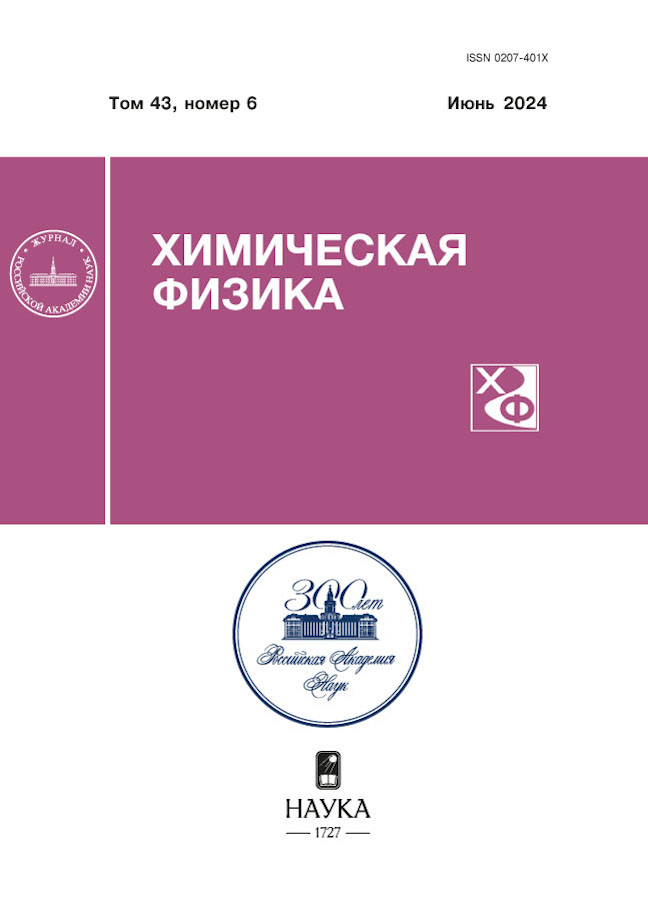Effect of particles of the young layer on the length ozone depletion chains in the atmosphere
- Authors: Larin I.K.1, Pronchev G.B.1, Yermakov A.N.1
-
Affiliations:
- Semenov Federal Research Center for Chemical Physics, Russian Academy of Sciences
- Issue: Vol 43, No 6 (2024)
- Pages: 64-71
- Section: Химическая физика атмосферных явлений
- URL: https://kld-journal.fedlab.ru/0207-401X/article/view/674937
- DOI: https://doi.org/10.31857/S0207401X24060074
- ID: 674937
Cite item
Abstract
The paper presents the results of calculations of the length of ozone destruction chains in the lower stratosphere in HOx-, NOx- and ClOx - catalytic cycles, taking into account heterogeneous chemical reactions (GHR) involving particles of the Young layer. Taking into account these reactions leads to a change in the type of high-altitude profiles of the length of the chains in these cycles, calculated in the approximation of the absence of GHR. At the lower boundary of the Young layer, a degeneration of the chain destruction of ozone in the NOₓ cycle is observed, caused by a sharp decline in the concentrations of components of this family due to the capture of gas molecules N₂O₅. At the same time, there is an increase in the chain length in the HOx cycle by more than an order of magnitude due to a decrease in the concentrations of OH and HO₂ radicals and, as a result, a decrease in the rate of chain breakage with their participation. At high altitudes, the length of the ozone destruction chains, taking into account GHR, on the contrary, are higher; the acceleration of the destruction of O₃ by chain carriers in HOx and ClOx cycles affects. The increase in their concentrations is due to the reduced content of NO and NO₂ in the air. The considered effect of GHR practically disappears at the upper boundary of the Young layer due to the evaporation of particles.
Keywords
Full Text
About the authors
I. K. Larin
Semenov Federal Research Center for Chemical Physics, Russian Academy of Sciences
Author for correspondence.
Email: iklarin@narod.ru
Russian Federation, Moscow
G. B. Pronchev
Semenov Federal Research Center for Chemical Physics, Russian Academy of Sciences
Email: iklarin@narod.ru
Russian Federation, Moscow
A. N. Yermakov
Semenov Federal Research Center for Chemical Physics, Russian Academy of Sciences
Email: iklarin@narod.ru
Russian Federation, Moscow
References
- Andreae M.O., Jones C.D., Cox P.M. // Nature.2005. V. 435. № 7046. P. 1187; https://doi.org/10.1038/nature03671
- Kulmala M., Pirjola U., Mäkelä U. // Nature. 2000. V. 404. № 6773. P. 66; https://doi.org/10.1038/35003550
- Seinfeld J.H., Pandis S.N. Atmospheric Chemistry and Physics, from Air Pollution to Climate Change. Hoboken, New Jersey, USA: John Wiley & Sons, 2016.
- Salawitch R.J., Wofsy S.C., Wennberg P.O. et al. // Geophys. Res. Let. 1994. V. 21. № 23. P. 2547; https://doi.org/10.1029/94GL02781
- Larin I.K. // Russ. J. Phys. Chem. B. 2017. V. 11. № 2. P. 375; https://doi.org/10.1134/S1990793117020075
- Larin I.K., Ermakov A.N., Aloyan A.E. // J. Phys. Chem. B. 2016. V. 10. № 5. P. 860; https://doi.org/10.1134/S1990793116050079
- Kumpanenko I.V., Ivanova N.A., Dyubanov M.V. et al. // Russ. J. Phys. Chem. B. 2021. V. 15. № 5. P. 868; https://doi.org/10.1134/S1990793121040047
- Zelenov V.V., Aparina E.V. // Russ. J. Phys. Chem. B. 2023. V. 17. № 1. P. 234; https://doi.org/10.1134/S1990793123010141
- Eganov A.A., Kardonsky D.A., Sulimenkov I.V. et al. // Russ. J. Phys. Chem. B. 2023. V. 17. № 2. P. 503; https://doi.org/10.1134/S1990793123020240
- Borrmann S., Solomon S., Dye, J.E. et al. // J. Geophys. Res. 1997. V. 102. D3. P. 3639; https://doi.org/10.1029/96JD02976
- Lary. D.J. // J. Geophys. Res. 1997. V. 102. D17. P. 21515; https://doi.org/10.1029/97JD00912.
- Scientific Assessment of Ozone Depletion: 1994, Global Ozone Research and Monitoring Project. Report. WMO, Geneva, 1995.
- Brasseur G., Solomon S. Aeronomy of the Middle Atmosphere: Chemistry and Physics of the Stratosphere and Mesosphere. Third revised and enlarged edition. Montreal. Canada.: Springer, 2005.
- Jacob D.J. Introduction to Atmospheric Chemistry. Princeton: University Press, 1999.
- Shimazaki T. Minor constituents in the middle atmosphere. Tokyo, Japan: Terra Scientific Publishing Company, 1985.
- Junge C.E., Chagnon C.W., Manson J.E. // J. Geophys. Res. 1961. V. 66. № 7. P. 2163; https://doi.org/10.1029/JZ066i007p₀2163
- Turco R.P., Whitten R.C., Toon O.B. // Rev. Geophys. 1982. V. 20. № 2. P. 233; https://doi.org/10.1029/RG020i002p₀0233
- Larin I.K. // Atmos. Clim. Sci. 2013. V. 3. № 1. P. 141; https://doi.org/10.4236/acs.2013.310¹⁶
- Eremina I.D., Chubarova N.E., Aloyan A.E., Arutyunyan V.O., Larin I.K., Yermakov A.N. // Izv. Atmos. Ocean. Phys. 2015. V. 51. № 6. P. 624; https://doi.org/10.1134/S0001433815050047
- Voigt C., Schlager H., Luo B.P. et al. // Atmos. Chem. Phys. 2005. V. 5. P. 1371; https://doi.org/10.5194/acp-5-1371-2005
- http://cdp.ucar.edu/browse/browse.htm?uri=http://dataportal.ucar.edu/metadata/acd/software/Socrates/Socrates.thredds.xml
- Schwartz S.E., Freiberg J.E. // Atmos. Envir. A. 1981. V. 15. № 7. P. 1129; https://doi.org/10.1016/0004-6981(81)90303-6
- Myhre G., Berglen T.F., Myhre C.L.E. et al. // Tellus. 2004. V. 56B. P. 294; https://doi.org/10.1111/j.1600-0889.2004.00106.x
- http://www.aim.env.uea.ac.uk/aim/aim.php
- Shi Q., Jayne J.T., Kolb C.E. et al. // J. Geophys. Res. 2001. V. 106. P. 24259; https://doi.org/10.1029/2000jd000181
- Hanson D.R., Ravishankara A.R., Solomon S. // J. Geophys. Res A. 1994. V. 99. D2. P. 3615; https://doi.org/10.1029/93JD02932
- Larin I.K., Ermakov A.N., Aloyan A.E. // J. Phys. Chem. B. 2021. V. 15. № 3. P. 577; https://doi.org/10.1134/S199079312103009X
- Carslaw K.S., Peter T., Clegg S.L. // Rev. Geophys. 1997. V. 35. № 2. P. 125; https://doi.org/10.1029/97RG00078
Supplementary files












